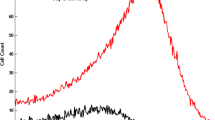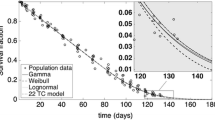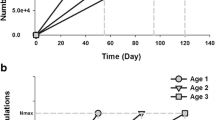Abstract
Age-structured cell population model was introduced to describe cell survival. The impact of the environment on the cell population is represented by drug plasma concentration. A key model variable is the hazard of cell removal that is a subject to the environment effect. The model is capable of describing cohort and random labeling cell survival data. In addition, it accounts for cell loss due to labeling of cell sample, but it lacks ability to describe the effect of label elution on the survival data. The model was applied to red blood cell (RBC) survival data in two groups of Wistar rats obtained by two techniques: cohort labeling using 14C-glycine (N = 4) and random labeling using biotin (N = 8). The Weibull probability density function was selected for the RBC lifespan distribution. The data were simultaneously fitted by the mixed effects model implemented in Monolix 4.3.3. The estimated typical values of RBC lifespan and age were 53.7 and 27.8 days, respectively. A noticeable effect of biotinylation on RBC survival was observed that resulted in a significant difference between the means of individual RBC lifespan for two groups. The model provides a mechanistic framework flexible enough to account for various experimental designs to generate the cell survival data. Despite model qualification using animal data, the model has the same potential to be applied to cell survival data analysis in humans.




Similar content being viewed by others
References
Uehlinger D, Gotch F, Sheiner L (1992) A pharmacodynamic model of erythropoietin therapy for uremic anemia. Clin Pharmacol Ther 51:76–89
Cohen RM, Franco RS, Khera PK, Smith EP, Lindsell CJ, Ciraolo PJ, Palascak MB, Joiner CH (2008) Red cell life span heterogeneity in hematologically normal people is sufficient to alter HbA1c. Blood 112:4284–4291
Kimmel M, Grossi A, Amausi J, Vannucchi AM (1990) Non-parametric analysis of platelet lifespan. Cell Tissue Kinet 23:191–202
Berlin NI, Berk PD (1975) The biological life of the red cell. In: Surgenor DM (ed) The Red Blood Cells, vol II. Academic Press, New York
Mock DM, Lankford GL, Widness LF, Burmiester DK, Strauss RG (1999) Measurement of red cell survival using biotin-labeled red cells: validation against 51Cr-labeled red cells. Transfusion 39:156–162
Willekens F, Roerdinkholder-Stoelwinder B, Groenen-Doepp Y, Bos H, Bosman G, Van Den Bos A, Verkleij A, Werre J (2003) Hemoglobin loss from erythrocytes in vivo results from spleen-facilitated vesiculation. Blood 101:747–751
Paulus JM (1971) Measuring mean lifespan, mean age, and variance of longevity in platelets. In: Paulus JM, Aster RH, Breny H (eds) Platelet kinetics, radioisotopic, cytological, mathematical, and clinical aspects. North-Holland Publishing Company, Amsterdam
International Council for Standardization in Haematology (ICSH) (1980) Recommended methods for radioisotope red-cell survival studies. Br J Haematol 45:659–666
Bergner P-EE (1962) On the stochastic interpretation of cell survival curves. J Theor Biol 2:279–295
Breny H (1971) Non-stationary models. In: Paulus JM, Aster RH, Breny H (eds) Platelet kinetics, radioisotopic, cytological, mathematical, and clinical aspects. North-Holland Publishing Company, Amsterdam
Lledo-Garcia R, Kalicki RM, Uehlinger DE, Karlsson MO (2012) Modeling of red blood cell life-spans in hematologically normal populations. J Pharmacokinet Pharmacodyn 39:453–462
Shrestha RP, Horowitz J, Hollot CV, Germain MJ, Widness JA, Mock DM, Veng-Pedersen P, Chait Y (2016) Models for the red blood cell lifespan. J Pharmacokinet Pharmacodyn 43:259–274
Metz JAJ, Diekmann O (1986) The dynamics of physiologically structured populations. Springer, Berlin
Krzyzanski W (2015) Pharmacodynamic models of age-structured cell populations. J Pharmacokinet Pharmacodyn 42:573–589
Garrick LM, Chu ML, Rusnak-Smalley P, Garrick MD (1987) Post-synthetic modification in vivo of the major hemoglobin beta chain in the rat. Hemoglobin 11:497–510
Franco RS (2012) Measurement of red cell lifespan and aging. Transfus Med Hemother 39:302–307
Korell J, Coulter CV, Duffull SB (2011) Evaluation of red blood cell labelling methods based on a statistical model for red blood cell survival. J Theor Biol 291:88–98
Korell J, Vos FE, Coulter CV, Schollum JB, Walker RJ, Duffull SB (2011) Modeling red blood cell survival data. J Pharmacokinet Pharmacodyn 38:787–801
Wiczling P, Krzyzanski W, Zychlińska N, Lewandowski K, Kaliszan R (2014) The quantification of reticulocyte maturation and neocytolysis in normal and erythropoietin stimulated rats. Biopharm Drug Dispos 35:330–340
Derelanko MJ (1987) Determination of erythrocyte life span in F-344, Wistar, and Sprague-Dawley rats using a modification of the [3H]diisopropylfluorophosphate ([3H]DFP) method. Fundam Appl Toxicol 9:271–276
Acknowledgements
Authors are thankful to Dr. Michael Garrick from University at Buffalo for his help with implementing the 14C-glycine labeling protocol into the cohort RBC labeling study.
Author information
Authors and Affiliations
Corresponding author
Electronic supplementary material
Below is the link to the electronic supplementary material.
Rights and permissions
About this article
Cite this article
Krzyzanski, W., Wiczling, P. & Gebre, A. Age-structured population model of cell survival. J Pharmacokinet Pharmacodyn 44, 305–316 (2017). https://doi.org/10.1007/s10928-017-9520-6
Received:
Accepted:
Published:
Issue Date:
DOI: https://doi.org/10.1007/s10928-017-9520-6




